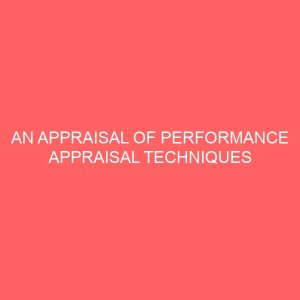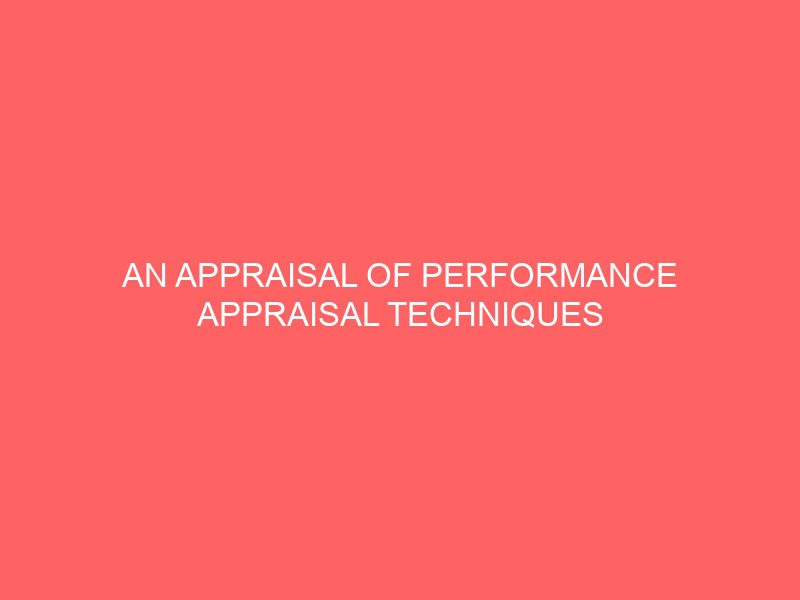Description
BACKGROUND OF THE STUDY
PA can improve motivation and performance, but if used inappropriately, it can have disastrous effects (Fisher et al, 2003). For PA to be effective, it must of necessity be anchored on the performance criteria that have been outlined for the job. Riggio (2003) describes performance criteria as the means for determining successful or unsuccessful job performance. They are one of the products of a detailed job analysis. Performance criteria spell out the specific elements of a job and make it easier to develop the means of assessing levels of successful or unsuccessful job performance. It can thus be inferred that an appraisal system not hinged on this all important criteria, can neither be appropriate nor fair, particularly to the employee, whose performance is being evaluated. In fact, some key points in the arguments of those opposed to performance appraisal is that, most of the time, wrong things are rated and the wrong methods used (Deming, 1986; Gilliland and Langdon, 1998).PERFORMANCE APPRAISAL
Situations arise whereby only some selected job elements are evaluated or given preference or higher points above other job elements in which the employee was equally engaged during the review period. This calls to
question the fairness of the appraisal system and its ability to effectively produce the desired outcomes. Mickerney (1995) underscored the intricacy of PA by describing it as a difficult and complex activity which is often not performed well by many organizations. The end result of this is that it produces exactly the opposite effect to those intended (Coleman, 1995).
1.2 STATEMENT OF THE PROBLEM
In Nigeria today, the general state of poverty makes economic reward a very important reason why people go out to work, thereby making money to rank highly as a critical motivator (Muo, 2007).This situation has made it imperative for Nigerian workers to pay particular attention to human resource (HR) practices which have direct bearing on their financial rewards and social status. One of such HR activities is performance appraisal (PA), which is the focus of this study.
A major outcome of PA is promotion and its attendant increase in financial benefits plus enhanced professional and social status (Tessema and Soeters, 2006; Shahzad, Bashir and Ramay, 2008). Performance appraisal outcomes tend to have high motivational impact and are a major determinant of employee performance.
It must be emphasized that an effective performance appraisal system is one that takes cognizance of all the components of an employee’s job performance, and does not focus on selected ones.
If used effectively, PA can improve motivation and performance, but if used inappropriately, it can have disastrous effects (Fisher et al, 2003). For PA to be effective, it must of necessity be anchored on the performance criteria that have been outlined for the job which in many case is overlooked. Riggio (2003) describes performance criteria as the means for determining successful or unsuccessful job performance. They are one of the products of a detailed job analysis. Performance criteria spell out the specific elements of a job and make it easier to develop the means of assessing levels of successful or unsuccessful job performance. It can thus be inferred that an appraisal system not hinged on this all important criteria, can neither be appropriate nor fair, particularly to the employee, whose performance is being evaluated. In fact, some key points in the arguments of those opposed to performance appraisal is that, most of the time, wrong things are rated and the wrong methods used (Deming, 1986; Gilliland and Langdon, 1998).PERFORMANCE APPRAISAL
Therefore the problem confronting this research is to appraise the effect of performance appraisal techniques on employee motivation.
1.3 RESEARCH QUESTION
I What is the nature of performance appraisal technique
1 What is the nature of employee motivation
2 What is the effect of performance appraisal technique on employee motivation
3 What is the nature of performance appraisal technique on employee motivation in the akwaibom state civil service.
1.4 OBJECTIVE OF THE STUDY
1 To determine the nature of performance appraisal techniques
2 To determine the nature of employee motivation
3 To determine the effect of performance appraisal technique on employee motivation
4 To determine the effect of performance appraisal technique on employee motivation in the akwaibom state civil services
1.5 SIGNIFICANCE OF THE STUDY
The study shall provide a conceptual and analytical appraisal of performance appraisal technique and its effect on employee motivation
It shall serve a veritable source of information to managers and human resource professionals.
1.6 STATEMENT OF HYPOTHESIS
1 Ho Performance appraisal is not significant in akwaibom state civil service
Hi Performanace appraisal is significant in akwaibom state civil service
2 HoEmployee motivation in akwaibom state civil service is low
Hi Employee motivation in akwaibom state civil service is high
3 Ho The effect of performance appraisal technique on employee motivation
In akwaibom state civil service is low
Hi The effect of performance appraisal technique on employee motivation
In akwaibom state civil service is high
1.7 SCOPE OF THE STUDY
The study focuses on the appraisal of performance appraisal technique
On employee motivation with a case study of the akwaibom state civil service.
1.8 Definition of terms
PERFORMANCE APPRAISAL
Performance appraisal (PA) is that part of the performance management process in which an employee’s contribution to the organization, during a specific period is assessed. According to Mullins (2002), the underlying objective of PA, is to improve the performance of the individual employee, thereby leading to improvement in the performance of the organization as a whole. PA is one of the ranges of tools that can be used to manage performance effectively, in that it provides data which feeds into other elements of the performance management process. As noted by Mathis and Jackson (2008), a PA system is often the link between additional pay and rewards that employees receive, and their job performance.
Motivation
Armstrong (2012) defines motivation as the force that energizes, directs, and sustains behaviour. It is concerned with the strength and direction of behavior, and the factors that influence people to behave in certain ways. Mathis and Jackson (2008) view motivation as the desire within a person that causes that person to act in order to reach a goal. Robbin (2000), offered a specific work-related definition of motivation as the willingness to exert high levels of effort towards organizational goals, conditioned by the effort and ability to satisfy some individual need. Roy (2001) defined work motivation as a process of energizing employees to the work goals through a specific path.







